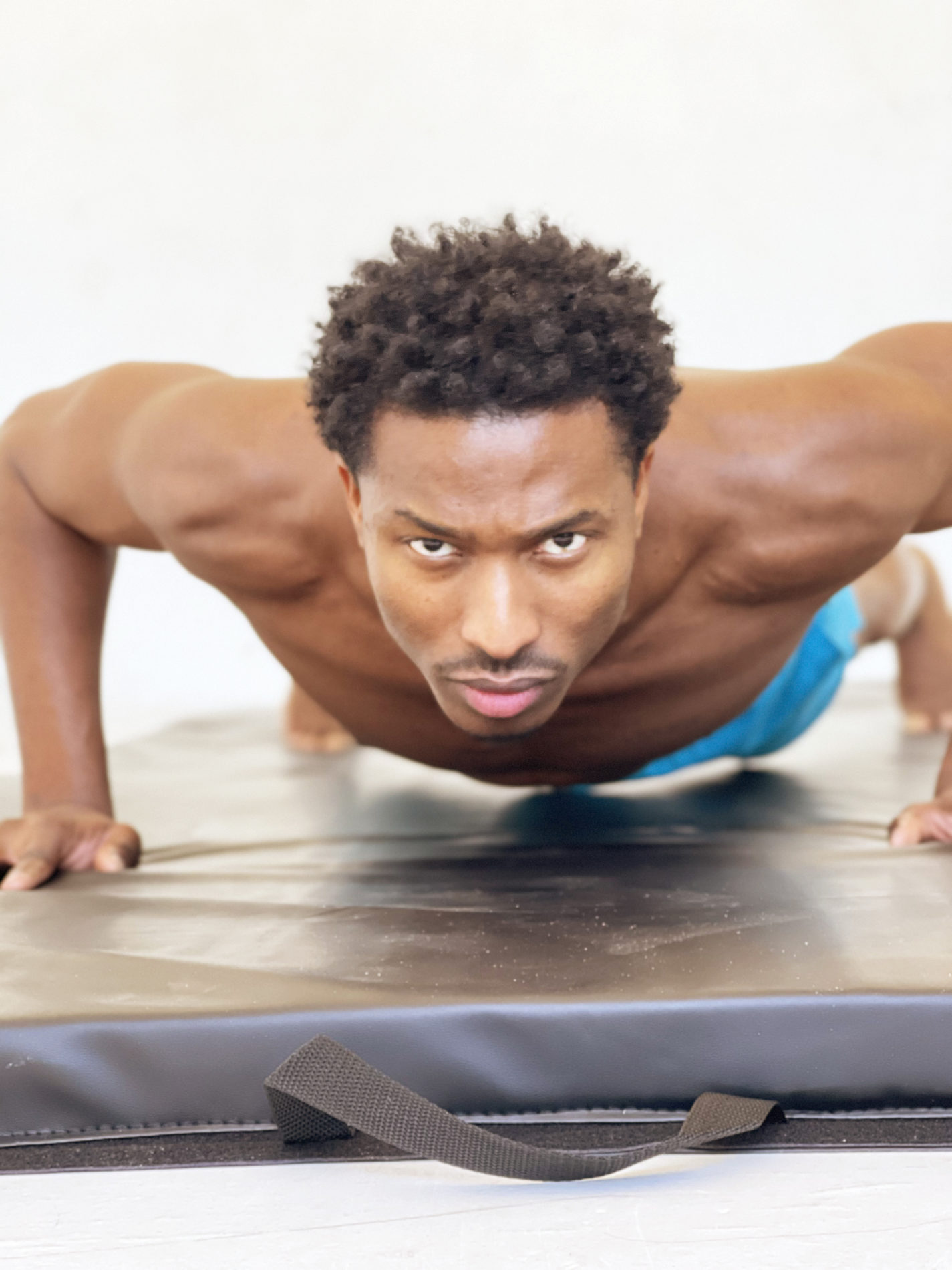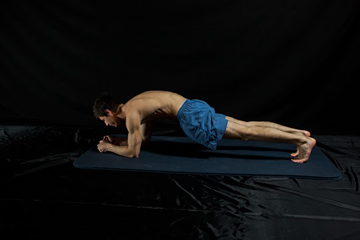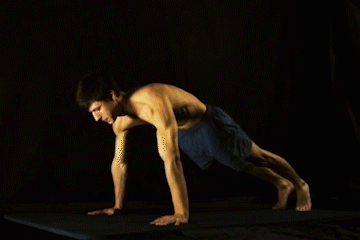
Join the tribe of Movement & Calisthenics Athlete – People just like you that are working with their own body weight to get strength, lose fat build muscle, recover from injuries and live their best lives!
The standard push-up is one of the best and most popular bodyweight exercises of all time right next to the pull-ups. Your regular gym class might probably have told you to drop down and do some reps.
Although it’s a basic bodyweight exercise and everyone should be able to at least perform a few reps to show a decent level of upper body strength, many still fail to perform even a single repetition of a push-up.
If you’re one of these individuals, don’t worry. Push-ups, no matter how basic it looks, is still a challenging move to perform. You need to be able to push up around 75% of your body weight to be able to perform with proper form.
Whether you’re aiming for weight loss, building muscles, or developing strength, learning how to do push-ups is a fantastic goal to achieve overall.
If you’re a beginner, an athlete who came from a training hiatus, or just interested to brush up on this calisthenics fundamental, then read on so you can perform them with good technique.
Push-ups demand dedication and discipline.
Normally, there are just two GENERAL reasons why can’t do a single push-up that we will, later on, break down so you can understand what can be causing the main issue.
Not prepared enough
The first and probably the main reason why you can do a single rep of the movement is that your body is not ready for the movement.
This upper-body exercise requires a strong chest, shoulders, and tricep for the pushing movement and also requires core strength for stability.
Not everyone who will try the push-up for the first time has enough foundational strength to do the move. Even some might struggle to support in the push-up starting position.
Have one weak point in one of the major targeted muscle groups then you will be struggling to perform even a single rep.
This is fine and not something you should worry about as we can strengthen the key areas you are struggling with you so you can finally get your first rep of proper and complete push-up.
Not aware of the technique
Known for some as press-ups, the push-up basic movement pattern is somehow familiar for almost everyone.
Just get down on the floor with your arms and legs straight. Bend your arms so that your chest almost touches the ground, then lift back to the starting position. Repeat for reps.
Seems easy enough, but the push-up actually demands a proper movement pathway to begin with if you want to train them correctly.
You might have enough strength to do push-ups but without the proper understanding of the movement, it will be difficult for you to perform the push-ups. Learning the technique might be difficult, especially if you already practiced it too much with incorrect form.
But the proper technique is worth the effort. Even though it’s much more difficult, it’s more efficient in helping you strengthen your chest, triceps, and shoulders, while minimizing the risk of injury.
How to fix it
Wall push-ups are fantastic for beginners for developing their basic strength and technique.
Use of progressions
The best way to get your first push-ups is to scale down the exercise. As we mentioned earlier, the major reason why you can’t do a single rep is unpreparedness. Your body is not used to the exercise so we need to build up the chest and arm strength for the motion.
Progressions are a set of exercises that build up the difficulty from the easiest variation of the exercise towards getting the actual move itself. In our case, it’s the push-up.
Progressions are the bread and butter of calisthenics. If you want to progress on exercises you want to learn, then you have to go through their respective progressions.
Think of progressions as adding more weight in weight lifting.
In traditional weight lifting mechanics, progressing is very straightforward. You have to continuously add plates to your dumbbell, barbell, or machine in order to progress.
In bodyweight training, we don’t have the luxury of adding weight in a linear approach which is why we take advantage of physics to achieve our goals. With push-up, we can modify our body position to put ourselves in a less mechanically disadvantageous position making the exercise easier.
We can either change our angle, our arm position, range of motion or do holds to alter the difficulty of an exercise.
Here’s the general progression set for the standard floor push-ups.
- Wall push-ups
- Incline push-ups
- Knee push-ups AKA modified push-ups
- Normal push-ups on the floor
This is only a summarized version, but you can already achieve regular push-ups on the floor using the progression. In between each progression, you can add some modifications depending on your weakness and skill level.
For example, you can use negative push-ups if you need to bridge your knee push-ups on the floor and the full normal push-ups.
You can also scale the incline push-ups by adjusting the level of the elevated surface. The higher the elevated surface, the easier the exercise. Go lower as you get stronger until you can go to your knees or even go to the ground.
With progressions, you also get to master the technique of push-ups as all of the progressions carry the general technique and movement pattern.
Address weaknesses
As you build your general technique and strength through progressions, you can also address sticking points and weak links that limit your capability to do one push-up.
You need to use your entire body for push-ups, so every muscle and joint should work in perfect unison to be able to perform it correctly.
Here are potential weak links that you need to solidify.
Wrists
Wrist preparation is needed for the sustained demands on the joins when performing push-ups.
Wrists are in a flexed position to do a normal push-up. For some, this could be challenging and put a strain on the small joints.
A proper wrist warm-up provides a massive difference when performing the exercise. It helps you prepare the joint and the forearm muscles which will be gripping the floor.
Of course, using the suitable progression for your skill level is also an excellent way to prepare your wrists.
Core
The plank hold is perfect for strengthening your core for the floor push-ups.
A weak core (not just abs) will let the hips sag when performing push-ups. Keep in mind, the push-up is basically a moving high plank position. You need to have a solid core to maintain a straight line, and solid stability.
Holding a plank position will tend to have an arching lower back to compensate for weak core muscles. This will result in lower back pains over time and lessen the global body tension which leads to less gains.
Another way to spot this is piking at the hips to break the straight line of the body.
Practice the plank position with a straight bodyline to avoid poor posture and push-up form.
A good guideline is to keep your hips tilted backward. This position is called a posterior pelvic tilt, an excellent cue to engage your core muscles when performing the exercise. Neck muscles in neutral, head in neutral.
Upper body
An obvious weakness is either weakness in the arm muscles, the chest, or the shoulders. Issues in the upper body should be addressed using the proper progression. Regress back to your knees, elevated surface, or on a wall before moving to the ground.
Shoulders
Weakness in the shoulders can be identified if you are unable to depress the shoulders or push them away from your ear. Avoid shrugging of the shoulders which can also strain your neck muscles.
Chest
The bulk of your pushing effort should focus on your chest. Weakness in this area generally manifests as an incomplete range of motion or adjustment of the spine to make the exercise easier.
Arms
A common issue with weak arms is when you tend to flare out the elbows. This motion lessens the contribution of your arms but an unnecessary strain on your shoulders which can cause an impingement if done repeatedly.
Learn the technique and form
What a regular push-up should look like for every rep.
These are the pointers you need to be aware of when performing your push-ups. Some are specific to normal floor push-ups, but most guidelines can apply to all variations, from wall to incline, to knees push-ups.
Coaching pointers
- Begin with arms shoulder-width apart
- Butt in, feet together
- Straight arms
- Straight bodyline
- Core engaged
- Exhale going down, inhale doing up
- Shoulders pressed away from your ears
- Shoulder blades pinched together at the bottom
- Head in a neutral position
- Perform in a controlled manner
What to avoid
- Neck strain
- Sagging hips
- Arms bend at the top
- Head sticking out or tucked in too much
- Incomplete range of motion
Check out the 10 common push-up mistakes that you might be doing in this article: DON’T SABOTAGE YOUR PROGRESS – 10 common push up mistakes you need to avoid
Conclusion
Film yourself with your phone cam. Watch your form and assess if you can do it properly before implementing the exercise in your workout.
Push-ups are a fundamental exercise that must be included in any workout. It’s amazing for any fitness level granted you’re doing the suitable progression for you.
Following these tips, with the addition of smart programming and dedication, will finally get you your first-ever full, ground push-ups.
If you need more help on programing and on your calisthenics fundamentals, get personalized help from The Movement Athlete.
Begin your personalized calisthenics journey by knowing how strong you really are.
TAKE THE ASSESSMENT NOW!









